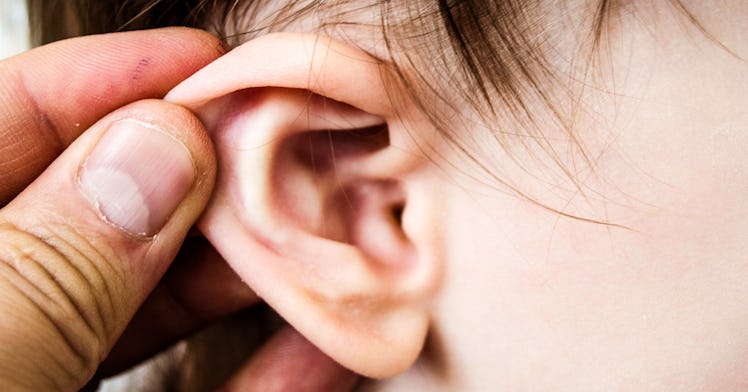Scientists Develop the First Smartphone App to Test for Ear Infections in Children
Repeated ear infections are hard on parents and kids, but new technology might make them easier to diagnose.

Scientists have developed a new smartphone app to help parents test children for ear infections from their own home. A new study, published in Science Translational Medicine, shows that the user-friendly technology may be nearly as accurate as tests at the doctor’s office and could save a lot of time for parents and pediatricians, and help sick kids get better more efficiently.
“Middle ear fluid and ear infections affect more than 80 percent of children and are the most common reason that parents bring children to a pediatrician,” study co-author Shyam Gollakota, an associate professor of Computer Science & Engineering at the University of Washington, told Fatherly.
Ear infections occur when fluid builds up in the middle ear, behind the eardrum. Such infections can also lead to acute otitis media (AOM), which can progress to meningitis. Painful fluid buildup without an infection, a condition known as otitis media with effusion, can also be a problem for young children. In addition to being painful, these issues make it difficult for babies and toddlers to hear, which in turn can make it harder to learn how to talk.
Because babies and many toddlers can’t verbalize that they’re in pain, these infections can be difficult to diagnose. Other symptoms include fevers and ear tugging, but not all kids experience these, making it even more challenging for moms and dads to know when to go to the doctor.
“We wanted to reduce the cost of health visits associated with ear infections as well as reduce the burden on parents by using a smartphone to detect this condition,” Gollakota explains, noting that detecting for fluid in the middle ear allows them to detect for all three possibilities.
Gollakota and his colleagues tested the technology on 98 patients between the ages of 9 months and 17 years old and found that it was effective at detecting fluid in children’s ears about 85 percent of the time — an accuracy rate that’s comparable to tests at the doctor’s office. The test only requires a small paper funnel that can be constructed with printer paper, tape, and scissors in under three minutes. The cone sits in the ear and the software sends a soft, audible chirp through it into the ear canal. Depending on the presence of fluid in the ear and where that fluid is, the ear and funnel will vibrate differently and produce sound reflections that can be tracked by the microphone in a smartphone. Using machine learning, an algorithm then determines if those reflections mean a child likely has middle ear fluid or not. Gollakota also found that the technology was effective across a variety of smartphone models and regardless of background noise (from, say, a crying sick toddler).
Gollakota and his team are currently working on obtaining FDA approval before bringing the app to the market. Still, the goal is not to use the technology to replace pediatricians, but to make their jobs easier by allowing them to use the app with patients and better coordinate their care.
“This tool has a similar purpose as a thermometer, which allows parents to monitor their child’s symptoms over time, and provides guidance about what steps they should take,” Gollakota says. “It could be useful for preventing unnecessary visits to the doctor. And for primary care providers, it could be used in conjunction with other symptoms when deciding whether to prescribe antibiotics to a patient.”